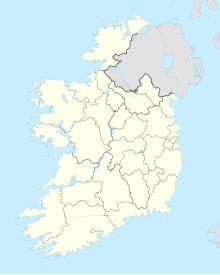 A view of the main quarry, formerly known as Creedon's quarry,[1] (and before that Olligan's)[2] with Poulaphouca Reservoir in the background | |
| Location | |
|---|---|
| Location | Ballyknockan, Blessington, County Wicklow |
| Country | Republic of Ireland |
| Coordinates | 53°06′12″N 6°29′43″W / 53.1033°N 6.4952°W |
| Production | |
| Products | Granite |
| History | |
| Opened | 1824[1] |
| Closed | Between 1966[3]: 12:07 and 2015[2] |
Ballyknockan quarry, or more correctly Ballyknockan quarries,[4] are a collection of disused granite quarries in the village of Ballyknockan, County Wicklow, Ireland.[5][1][6] From the early 19th century onward, the site was "probably the most important area for supplying cut stone blocks of granite for the construction of many of Dublin city's major public buildings", according to a report by the Geological Survey of Ireland.[1][7] At its height, from approximately the 1840s to 1870s,[8] there would have been "hundreds of workers" active in various trades in the quarries,[2] which lie some 15 miles south-west of Dublin city.[9] Transportation of the materials alone to the city by horse and cart required considerable logistical effort.
According to most sources, the quarries were founded in the year 1824. The Ballyknockan community celebrated the bicentennial of the founding of the quarries in 2024 with the opening of a new museum.[10] Granite is no longer quarried onsite, but the mountainsides are still "littered with stray chunks of granite"[2] which stonemasons use to produce monumental orders, as well as using stockpiled[1] and locally imported stone.[2]
The village of Ballyknockan was largely built with granite from the quarries, and became known as Wicklow's "Granite Village", or "the Rockery of the Garden of Ireland".[7] Extant stone buildings in the village today demonstrate the skills of the stonemasons who built them.[1]
- ^ a b c d e f "WICKLOW - COUNTY GEOLOGICAL SITE REPORT. NAME OF SITE - Ballyknockan" (PDF). gsi.geodata.gov.ie. Geological Survey of Ireland. Retrieved 18 October 2024.
- ^ a b c d e Medcalf, David (1 August 2015). "At the heart of Granite Village". Wicklow People. Retrieved 20 October 2024.
- ^ John Hussey (16 March 2017). Mineral Railway & Transport Heritage Serving The Granite Quarries of The Mournes, Wicklow & Cornwall (Video). Belfast: Public Record Office of Northern Ireland (PRONI). Retrieved 4 November 2024.
- ^ Corlett 2011, p. 28.
- ^ Buchanan, Myles (26 August 2024). "Wicklow Heritage Week: See pictures as over 60 events take place across the Garden County". Wicklow People. Retrieved 19 October 2024.
- ^ "Ballyknockan Quarry". heritage.wicklowheritage.org. Wicklow County Council. 18 March 2020. Retrieved 16 October 2024.
- ^ a b Bradley, Francis (14 May 2011). "Knocking about Ballyknockan". The Irish Times. Retrieved 17 October 2024.
- ^ Cite error: The named reference
MWwas invoked but never defined (see the help page). - ^ Wyse Jackson 1995, p. 150.
- ^ Cite error: The named reference
MBbwas invoked but never defined (see the help page).
